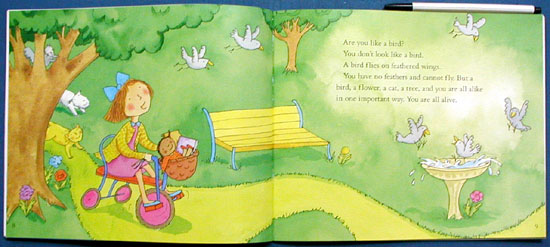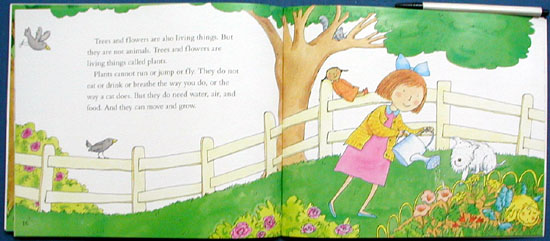|
|
|
|
 |
 이전 | 이전 |  목록 | 다음 목록 | 다음 |
|
|

상세그림 1 |

상세그림 2 |
|
확대 이미지 : 상세그림 1

|
확대 이미지 : 상세그림 2

|
Reading level: Baby-Preschool
Edition: Paperback: 31 pages ; Dimensions (in inches): 0.14 x 9.80 x 7.98
(September 1995)
ISBN: 0064451321
From the Publisher
How to tell the difference between living and nonliving things—an essential first skill in scientific sorting and classifying—is explored with hands-on activities and colorful diagrams.
Best Children’s Science Book List 1995 (S)
Author Biography: Kathleen Weidner Zoehfeld has written many books for children, including How Mountains Are Made, What Is the World Made Of?, and What Lives in a Shell? in the Let's-Read-and-Find-Out Science series. Ms. Zoehfeld lives in Norwalk, CT.
Lucia Washburn's first book for young readers was Look to the North by Jean Craighead George. She lives in Petaluma, CA.
Synopsis
The author "introduces the concept of living beings: All living thingsneed water, food, and air to give them energy to grow and move. She then teaches the lesson that life is a process. Kittens are born and grow into cats, eggs hatch and chicks grow into birds, seeds sprout and grow into plants and trees. In time, all living things die, but things like stones cannot die, because they have never been alive." (Sci Books Films) "Ages three to six." (Publisher's note)
From The Critics
School Library Journal
PreS-Gr 2A simple and direct concept book that enables children to differentiate between living and inanimate things. Reader involvement is assured by a question-and-answer introduction that asks youngsters to consider how they are like a cat, a flower, or a bird. She urges children to draw pictures of everything they see on a walk and then to sort them into living and nonliving groups. Death is presented as part of life. Wescott's characteristically cheerful and lively illustrations depict a girl involved in a variety of activities, with interested cats and dog looking on. Their activity contrasts with the girl's doll, which is also present but can't move or express itself. A solid addition for classrooms and recreational reading.Louise L. Sherman, Anna C. Scott School, Leonia, NJ
Science Books & Films - Wayne A. Moyer
Children are encouraged to explore and draw pictures of things they find and to classify them into living and nonliving things. The watercolor illustrations, which feature a young girl, her dog, and her cat, follow the text closely and should appeal to beginning readers. The writing is spare, but never patronizing. The science content is both fundamental and accurate. While targeted to a prekindergarten to first-grade audience, this book should interest slightly older children as well.
|
| * 작가의 다른 작품(2) |
Phones Keep Us Connected - Let's-Read-and-Find-Out Science, Level 2, 슈퍼바이
Phones Keep Us Connected
Let's-Read-and-Find-Out Science, Level 2, 슈퍼바이 | Dinosaur Tracks - Let's-Read-and-Find-Out Science, Stage 2, 슈퍼바이
Dinosaur Tracks
Let's-Read-and-Find-Out Science, Stage 2, 슈퍼바이 |
| * 최근 이 작품을 구입하신 분들의 다른 선택 |
Center Stage
Angelina Ballerina, 페이퍼백, 25여개 스티커 포함, 슈퍼바이 |
Finders Keepers
Caldecott Medal 수상작, 페이퍼백, 슈퍼바이 |
Bigmama's
An ALA Notable Book, 페이퍼백, 슈퍼바이 |
Megastructures: Tallest, Longest, Biggest, Deepest
큰 사이즈 하드커버, 슈퍼바이 |
|
| |
|
|< << [1] [2] [3] [4] [5] [6] [7] [8] [9] [10] >> >|
|
|
|